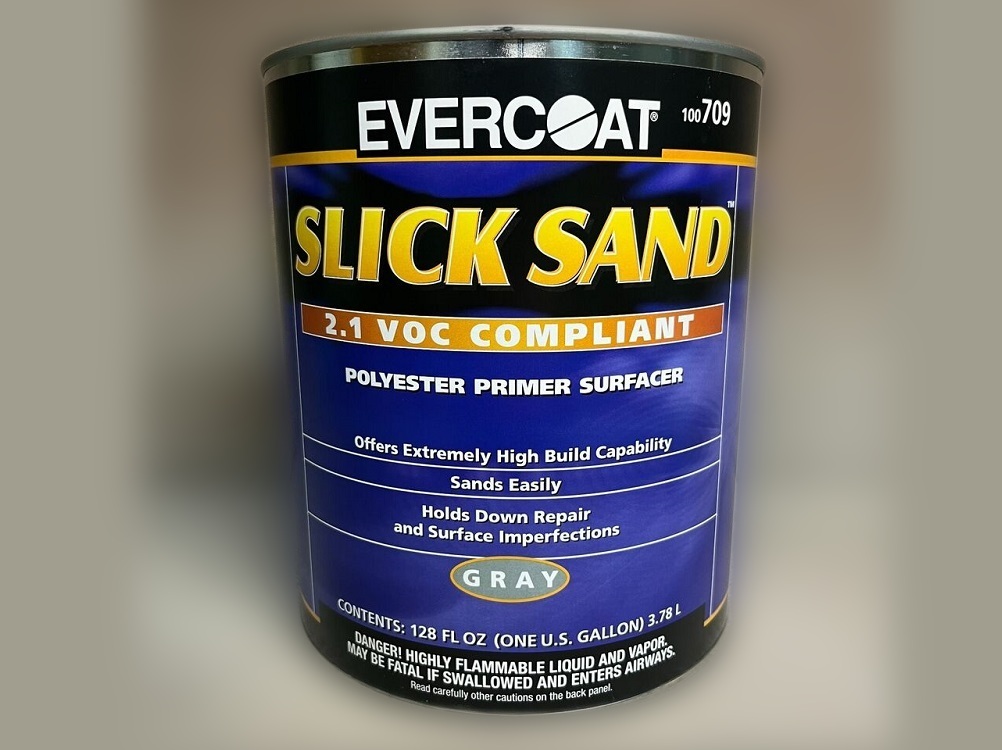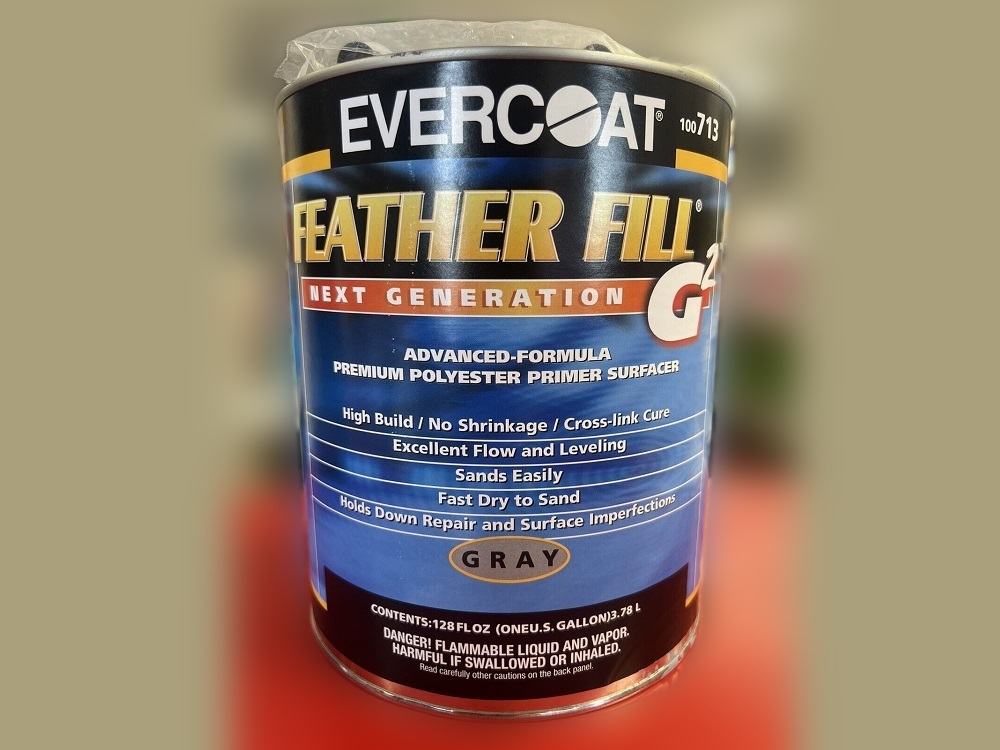When tackling an auto body project, choosing the right primer surfacer can make all the difference in the outcome. Two popular options in the automotive world are Slick Sand and Feather Fill.
Both are known for their unique properties and applications, but how do they stand against each other? Whether you’re a seasoned professional or a DIY enthusiast, understanding the distinctions of these products will help ensure your next project is smooth and successful.
Table of Contents
Slick Sand
Slick Sand is a high-build polyester primer known for its thick layering capability, effectively covering larger imperfections in vehicle bodies. This product is ideal for achieving a level surface on rough and uneven areas before painting.
Feather Fill
Feather Fill, on the other hand, serves a slightly different purpose. It’s a lighter primer that is perfect for smoothing out more minor blemishes and ensuring a fine finish.
Its formulation is less dense than Slick Sand, making it easier to apply on surfaces that require less extensive correction.

Formulation and Material Properties
Understanding the chemical makeup and physical characteristics of Slick Sand and Feather Fill can significantly influence their application and performance on different auto body projects. Here’s a deep dive into each formulation and material’s properties.
Slick Sand
Chemical Composition
Slick Sand is primarily composed of polyester resins. These resins provide the primer with high build properties, making it thick and suitable for substantial surface leveling. Including talc and various fillers enhances its viscosity and body-filling capacity.
Characteristics that Affect Adhesion and Coverage
The thick nature of Slick Sand allows it to adhere well to properly prepared surfaces, ensuring that even significant imperfections can be covered with fewer applications.
Its high-build formula fills and helps create a solid, durable layer that is less prone to shrinkage than other primers.
Feather Fill
Chemical Composition
Feather Fill is formulated with lighter polyester resins mixed with micro fillers that enhance its flow and ease of application. This composition makes it less viscous than Slick Sand, providing a smoother application on surfaces that require moderate correction.
Characteristics that Affect Adhesion and Coverage
The lighter formulation of Feather Fill allows for excellent adhesion to a wide range of surfaces, including slightly oily or older paint jobs, without compromising the quality of the finish.
It spreads evenly, offering consistent coverage that helps achieve a smooth, fine surface ideal for final painting.
Application Process
The proper application techniques can significantly influence the effectiveness and final appearance of both Slick Sand and Feather Fill. Here’s what you need to know about preparing surfaces and applying these products to achieve the best results.
Slick Sand
Surface Preparation Requirements
Proper surface preparation is crucial for Slick Sand to perform optimally. The surface must be clean, dry, and free from grease, oil, or loose paint.
To create a texture that enhances the primer’s adhesion, the area should be sanded with coarse sandpaper (around 180-220 grit).
Application Techniques and Recommended Tools
Slick Sand should be applied with a high-volume, low-pressure (HVLP) spray gun for best results. It typically requires a larger nozzle size due to its high viscosity.
Multiple coats may be necessary to achieve the desired thickness, allowing adequate flash-off time between layers to prevent runs and sags.
Feather Fill
Surface Preparation Requirements
For proper Feather Fill application, the surface needs to be cleaned and sanded thoroughly, similar to Slick Sand.
However, Feather Fill is finer, so it often requires a slightly smoother sanding approach (using 220-320 grit sandpaper) to prevent the texture from showing through the primer.
Application Techniques and Recommended Tools
Feather Fill is also best applied using an HVLP spray gun but can typically be handled with a smaller nozzle due to its lower viscosity than Slick Sand.
The application should be made in thin, even coats to build up the desired level of smoothness without over-application, which can lead to unnecessary sanding work later.

Drying and Curing Times
The drying and curing times of automotive primers like Slick Sand and Feather Fill are critical to efficiently planning and executing auto body projects. Understanding these times helps schedule subsequent steps, such as sanding and painting.
Slick Sand
Typical Drying Times Under Various Conditions
Slick Sand typically dries to the touch within 2 to 3 hours under normal conditions (around 70°F and 50% humidity). However, these times vary significantly based on ambient temperature and humidity levels. In cooler or more humid conditions, drying times may extend considerably.
Factors Affecting the Curing Process
The curing process for Slick Sand involves drying and achieving the hardness necessary for sanding and further layering.
Temperature is critical; higher temperatures can accelerate the curing process, while lower temperatures may slow it down.
Adequate ventilation is also crucial to ensure that the solvents in the primer can evaporate effectively, promoting faster curing.
Feather Fill
Typical Drying Times Under Various Conditions
Feather Fill dries faster than Slick Sand, usually becoming touch-dry within 1 to 2 hours under ideal conditions. This quicker drying time makes it preferable for projects requiring faster turnaround.
Factors Affecting the Curing Process
Like Slick Sand, Feather Fill’s curing is influenced by environmental factors such as temperature and humidity.
The thickness of the application also plays a significant role; thinner coats will cure faster than thicker ones. Ensuring the area is well-ventilated will also help reduce the overall curing time.
Sanding and Finishing
Achieving a perfect finish in auto body work depends on proper sanding and the quality of the final surface preparation. Both Slick Sand and Feather Fill offer distinct characteristics regarding sanding and final surface readiness for painting.
Slick Sand
Ease of Sanding After Application
Due to its high-build nature, Slick Sand typically requires more effort than lighter fillers. However, it sands smoothly when fully cured, allowing for the correction of significant surface imperfections.
It’s essential to use the right grit sandpaper—starting with a coarser grit to knock down high spots and gradually moving to finer grits for a smooth finish.
Final Surface Quality and Readiness for Painting
Once sanded, Slick Sand provides a flat, smooth surface, ideal for high-quality paint jobs. It’s particularly effective in scenarios requiring extensive surface leveling, offering a solid base that minimizes the risk of paint sinking into porous areas.
Feather Fill
Ease of Sanding After Application
Feather Fill is generally easier to sand than Slick Sand because of its lighter and less viscous nature. It can be quickly smoothed out, which reduces the overall labor and time involved in the sanding process. This feature makes it ideal for projects with tighter timelines.
Final Surface Quality and Readiness for Painting
The surface left after sanding Feather Fill is exceptionally smooth and flawless, making it excellent for final paint applications where a high-quality finish is desired.
It’s perfect for light to moderate imperfections and provides a good base that enhances the appearance and longevity of the paint.
Performance and Suitability
Choosing the right automotive primer affects the ease of application, final appearance, and longevity and effectiveness of the repair.
Let’s explore the performance characteristics and best-use scenarios for Slick Sand and Feather Fill to determine which primer surfacer best suits different auto-body projects.
Slick Sand
Best Use Scenarios (e.g., heavy filling, significant imperfections)
Slick Sand is particularly effective in scenarios requiring heavy filling. It addresses significant imperfections such as deep scratches, dents, or uneven surfaces.
Its high-build formula allows it to fill these imperfections efficiently, reducing the need for multiple applications and saving time in extensive repair jobs.
Longevity and Resistance to Shrinking
Thanks to its robust polyester resin base, Slick Sand exhibits excellent resistance to shrinking over time, maintaining the integrity and smoothness of the surface.
This characteristic ensures that the repairs last longer and the paint does not crack or sink, even under challenging environmental conditions.
Feather Fill
Best Use Scenarios (e.g., light to moderate imperfections)
Feather Fill is best suited for light to moderate imperfections. It’s perfect for projects that require a finer finish with less extensive surface correction.
Whether preparing a new panel or making minor adjustments to an existing paint job, Feather Fill can provide a smooth, pinhole-free surface ready for painting.
Longevity and Resistance to Shrinking
While Feather Fill also provides good resistance to shrinking, it is particularly noted for its ability to deliver a stable, smooth finish that enhances the appearance and durability of the topcoat.
It prevents issues such as cracking and peeling of the paint by ensuring a consistent and reliable base.
Conclusion
Both Slick Sand and Feather Fill serve crucial roles in auto body repair, each with unique strengths. Slick Sand is optimal for heavy-duty filling where extensive surface leveling is required, while Feather Fill excels in projects needing fine finishes and minor to moderate corrections.
Understanding the specific properties, application processes, and best-use scenarios will help you choose the most suitable primer for your project, ensuring durability, aesthetic appeal, and overall success of your auto body work.
Whether a professional or a DIY enthusiast, selecting the appropriate primer is crucial in achieving top-quality results.
